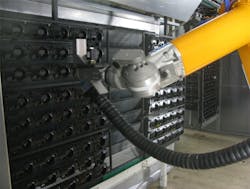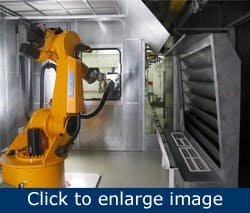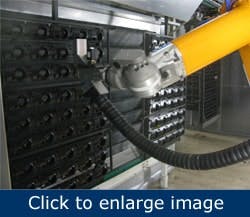Part cleaning technique enables sustainable practices
Less is more. Volkswagen Plastics Technology in Braunschweig, Germany, has started using a single-layer painting system for a new interior component. The process reduces the consumption of resources and pollutant emissions. However, the painting system demands an absolutely clean, residue-free surface. This has been achieved with the aid of a dry CO2 snow jet cleaning technique that is designed to be gentle on materials.
In order to economize on resources and costs, as well as reduce environmental damage, Volkswagen’s production plants implement technologies such as cogeneration units, biogas plants, filler-free body paints and thermal afterburners to recover energy from solvent-polluted exhaust air. In the development and manufacture of interior components such as panels, trims, ventilation grills and air diffusers, Volkswagen finds ways of further increasing sustainability at its Plastics Technology in Braunschweig.
Cleanliness
The CO2 snow jet system has been integrated into a large paint booth measuring 5.5 x 4 x 3 m together with a turning station. (Source: Volkswagen, Plastics Technology, Braunschweig)
Every day, Plastics Technology processes approximately 45 tons of granulate material to manufacture injection-molded parts. A range of about 450 interior components of different colors are produced and installed into various passenger vehicle models and the Multivan T5 around the world. Some of these are injection-molded parts with a high-gloss finish, and they can be installed without needing to be coated. One of the latest vehicle models produced by the European car manufacturer is fitted with a high-gloss panel made from acrylonitrile-butadiene-styrene, polycarbonate (ABS-PC) blend, which is subsequently painted with a semi-transparent high-gloss metallic paint. “This paint is applied to the component as a single layer without an undercoat, so the surface has to be flawless,“ explains Uwe Strauss, painting systems/plastics technology planning at the Braunschweig plant. “The tiniest dust particle or water mark would cause rejects. Therefore, we needed a cleaning solution that is efficient, is gentle on materials, and guarantees consistent results.”
CO2 snow
The classic alternative — wet-chemical cleaning with a powerwash system — was mainly rejected for reasons of cost-effectiveness and sustainability. However, due to its high space requirements, it would have been impossible to install such a cleaning system upstream of the paint shop. In tests with conventional dry-ice cleaning systems, it was observed that the coarse ice pellets damaged the sensitive surface of components when used as a cleaning medium. The CO2 snow jet process from Advanced Clean Production (ACP, www.acp-micron.com) gave Volkswagen an alternative. “We told one of the company’s employees about what we needed,“ recalls Strauss. “It wasn’t long before we were sent a proposal for a solution, and tests confirmed that we could achieve optimum cleaning results with the process.” With the CO2 snow jet technique, liquid carbon dioxide is used instead of dry-ice pellets. Carbon dioxide gas is produced as a by-product in a variety of manufacturing processes in the chemical industry; it is environmentally neutral and gentle on resources.
Residue-free
[pullquote]The modularly constructed CO2 snow jet system achieves its effective cleaning power via the supersonic two-component ring nozzle integrated into the compact cleaning head. Liquid carbon dioxide is guided through the nozzle and expands on exit to form a mixture of snow and gas. Oil-free compressed air is fed to the core jet as a jacketed jet, accelerating the non-toxic, non-combustible CO2 snow crystals to supersonic speed. When the jet impacts on the surface to be cleaned, the snow crystals liquify and then sublimate. The sublimation impulse causes any particulate contamination present to detach and be carried away. In the liquid phase, carbon dioxide also acts as a solvent which removes organic contamination. At the same time, the low degree of hardness of the snow crystals is designed to ensure gentle and reproducible cleaning results on the high-gloss surface of the component. “During the test phase we also carried out test series with other components made of different materials,“ reports Strauss. “This proved that the CO2 cleaning process can be implemented for our entire range of workpieces.”
Painting integration
Component-specific cleaning programs are filed in the robot controls for approximately 20 different workpieces. To prevent recontamination, all dirt which has been removed is extracted. (Source: Volkswagen, Plastics Technology, Braunschweig)
In line with Volkswagen Plastics Technology requirements, ACP designed a robotic cleaning system with a nozzle array containing seven cleaning heads. The component-specific programs filed in the robot controls ensure that each of the approximately 20 different workpieces is cleaned fully and automatically, according to its geometry. Oil-free compressed air and liquid carbon dioxide stored in tanks are fed to the array via a hose system.
The robot installation is integrated into a booth measuring approx. 5.5 by 4 by 3 m. The cleaning cell located at the rear wall has a continuous extraction unit. This prevents cleaned parts from becoming recontaminated by dirt as it’s removed. A turning station, which can be switched on separately, is located in the booth downstream of the cleaning process, allowing suspension gear to be rotated by 180°. “ACP provided us with ideal support both during the test phase and afterward, when we started implementing the cleaning system, enabling us to integrate it into the painting process within the space of just three months,” says Strauss.
Series operation
The CO2 snow jet system has been running in three-shift series operation at the Volkswagen works in Braunschweig since August 2010. Several thousand plastic parts are cleaned by it every day.
“The workpieces are suspended on special painting racks directly at the injection-molding plant,“ explains Strauss. “If high-gloss parts are handled, workers wear gloves.“ The racks are mounted on trolleys, transported to the painting line and fed into the painting chain. The first station in the line is the cleaning unit. To prevent any dust from sedimenting on the workpieces after cleaning, they’re fed through a station fitted with two ionizing rods. After being transported along a short stretch designed as a cleanroom, paint is then applied to the components by two robots in the painting booth. On leaving the evaporation zone, the parts are then dried at around 80 °C.
"With the CO2 snow jet system, we’ve not only found a cost-effective and reliable cleaning solution, we’ve succeeded in reducing the workload on our staff, decreasing environmental pollution and also lowering our reject rate by another 3%,” summarizes Strauss.


